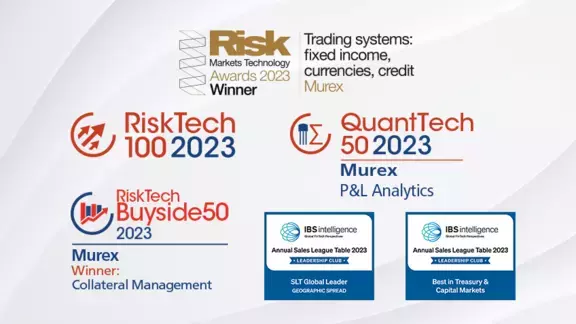-
Our solutions
- Our clients

With 300 clients and 60,000 users spread across 60 countries around the world, Murex has a truly international client base of capital markets participants.
view all case studies- Insights
- Who we are

Our awards highlight a strong level of customer satisfaction and acknowledge our market expertise.
Visit our awards webpage- Our partners
- Careers
Murex FX Options Product Spotlight: Real-Time Portfolio Management
The state of the portfolio in real-time is illuminated and clear, providing deep and comprehensive perspective
by Rémy Lagache, Head of FXO Trading Product Management, Murex
Traders operate in a fluid context that requires adaptability, flexibility, transparency, accuracy and real-time responsiveness.
In the introductory article of this series, we outlined an increasingly complex and challenging environment, along with impending regulatory changes that traders face.
This piece zooms in on FX options real-time portfolio management and how this meets evolving trader needs. And these needs are always changing—new possibilities and better capabilities that enable more efficient execution and risk management are expected.
Traders look for key differentiators and embedded business content is important and valued. Traders benefit from being able to see an illuminated and clear state of their portfolios in real-time.
Fit-to-purpose for the FX options trading desk, the best of the real-time portfolio management functionality can be taken advantage of out-of-the-box. It is enhanced continuously to ensure it provides mature and useful business content for players who are not keen on building in-house systems from the ground up. In some ways, this is a democratizing offering: it provides tailored options trading desk features that would typically need to be built at considerable cost and effort in-house to clients of all types and sizes.
Traders can expect evolving features that incorporate best practices in FX options trading; what-if scenario flexibility; and enhanced P&L (profit and loss) attribution for daily activity, for example. Traders can also expect enhanced, seamless navigation, with high responsiveness to user actions and increased ergonomics.
In MX.3, FX options traders execute critical actions from a single screen, manage their portfolios in real time and benefit from:
• Clearly illustrated portfolio exposure. A banner details the main information with a split between daily, monthly, yearly, and absolute P&L. A summary screen includes portfolio exposure by currency pair, using market data details and showing the aggregated position on currency pairs and the aggregated greeks for each currency pair. Conveniently, it provides the ability to hedge each exposed currency against a non-risky one.
• Daily process tracking. It provides focused monitoring of the book’s barrier positions, enhanced barrier knock statuses for a better fit to market practice and the ability to trigger the knock directly from the barrier management screen. Barrier management is tailored for American, European and discrete barriers. An expiry analysis function applies focused monitoring with the display of long and short positions.
• Measurement of stresses and portfolio exposure against market moves. It features what-if scenarios, such as spot bumps, volatility moves and date shifts, among others, as well as barrier and strike topography, and smile scenarios stress volatility surface, point-by-point.
• Specific focus on the activity of the day. Trades inserted on monitored portfolios can be quickly accessed, along with global trade information and visualization of current market operations performed on monitored portfolios.
Previously, all traders tended to work, in one sense, autonomously, with their own view of the book, their own unique view of the portfolio and the situation. The data individual users see is harmonized, proving a consistent frame of the same picture. Desk managers have the same view of positions and leverage the same architecture to align their teams.
Important capabilities have recently been enriched, providing:
• Quick access and easy drill-down capabilities from any P&L or sensitivity figure, along with access to position and trade details.
• Control of new trade impacts before they hit their positions.
• A view of the impact of hypothetical trades, anticipating hypothetical client deals or potential hedges.
• Refresh of volatility or spot on demand.
• Ability to trigger the refresh of risk matrices from the refresh of P&L views.
• Capacity to run on-the-fly scenarios on the entire book.
Murex has closely followed the market’s transition to a new generation of pricing models that are more computationally demanding than what has previously been seen. Take one such computationally demanding example—the stochastic local volatility model. The position and risk management ability to support such models—those that exist already and those to come—enables both Murex and its clients to be ready for future market evolution.
In the next article in this series, we will drill down on the stochastic local volatility model, among other FX options models. Stay with us and learn more about our FX options trading capabilities.
You might be interested in ...
- Our clients


